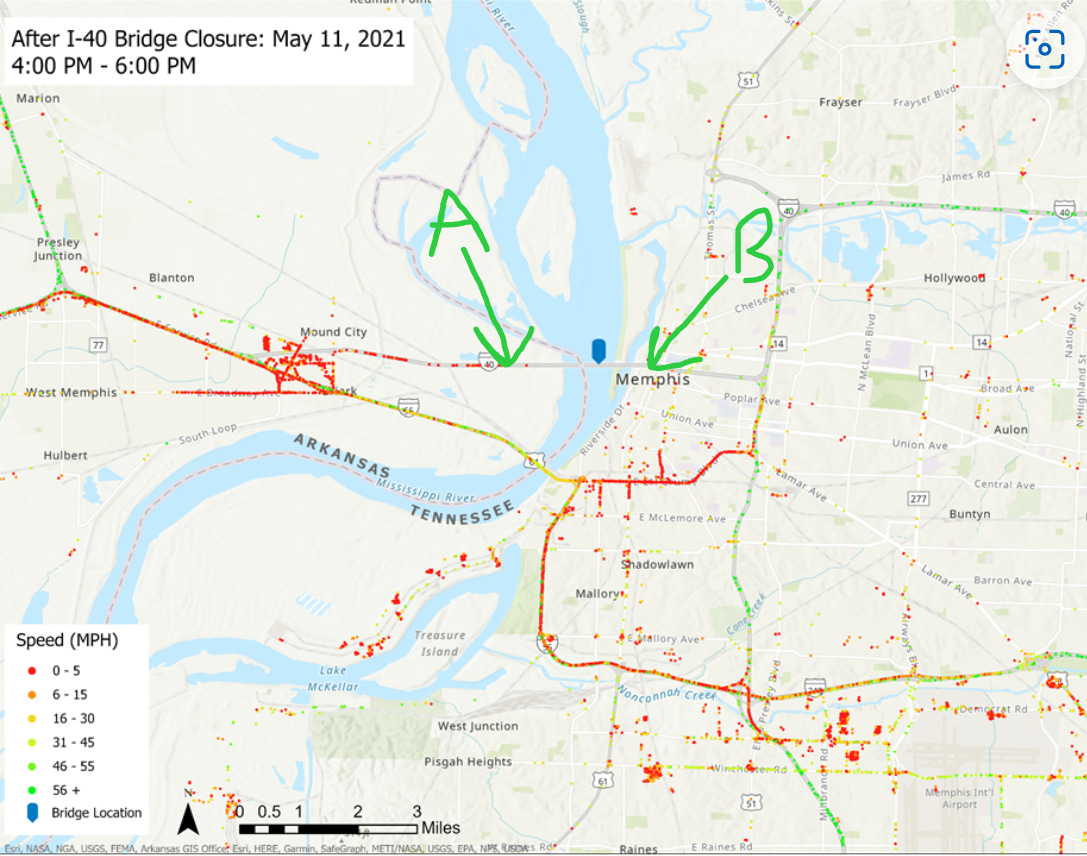Agile Marketing for Startups: An Interview With UpSmith's Julie Yang
How to Drive Impactful Marketing Outcomes When You Have No Data to Guide You
In 2021, the I-40 bridge over the Mississippi suddenly closed for months—An inspector saw a major crack and, not waiting for slow form-filing, immediately called 911.
Instantly, 35,000 vehicles a day crawled at walking speed for hours through the nearest detour.
Engineers jumped into action and made remediation plans—they pulled:
materials strength tables
budgeting estimates based on traffic & weight loads
construction project timing
and made a plan to go forward.
In other words, they were data-driven. They used data they had to plan for the future.
And when you have data, you should use it to inform your decisions.
But what happens when you’re doing something entirely new? Something without any engineering tables you can rely on?
Imagine a startup with a groundbreaking product but no existing sales.
The team has no historical data, no established marketing channels, and no benchmarks1 to guide their efforts.
They’re starting from scratch, and every marketing dollar feels like a gamble.
This scenario is all too familiar for early-stage startups, where uncertainty is the only constant.
What should you do?
Julie Yang, the head of growth at UpSmith, has experience across startups with that exact problem.
What has she found succeeds? Agile marketing—a framework designed for exactly these unclear conditions.
Agile marketing is where startups experiment rapidly, adapt to market feedback, and iterate toward success without relying on traditional2, data-heavy strategies.
By focusing on small, outcome-driven campaigns startups can test new channels and content efficiently, even when there’s no roadmap to follow.
In this article, we’ll explore Julie’s perspective on how agile marketing principles let startups navigate uncharted markets.
The Agile Marketing Framework for Startups
Agile marketing is an iterative, flexible approach that prioritizes experimentation over rigid, long-term strategies.
As Julie said on her experience with agile marketing:
“[We found success] trying to cater to outcomes and breaking down these monolithic campaigns… to drive experimentation through these smaller campaigns to then get to the outcome”.
It’s about breaking down large campaigns into smaller initiatives that can be adjusted based on real-time feedback.
This makes it ideal for startups, where market conditions are unpredictable and resources (both money and attention) are limited.
This shift from activity-focused marketing to outcome-driven experimentation is crucial for startups.
It allows teams to stay nimble and focus on what truly works.
But agile marketing isn’t just about processes—it’s about fostering a culture of creativity and adaptability.
In uncharted markets, human intuition and quick thinking are going to be more important than following ‘industry best practices’ for channel mix.
Challenges of Marketing Without Established Channels
Startups releasing a new product face a unique marketing dilemma: without historical data or established channels, it’s nearly impossible to rely on traditional metrics like A/B testing or conversion benchmarks.
Julie’s worked on teams that had absolutely 0 data to guide her:
“We were so new that it wasn't even to the point where I could really like AB test… I don't think I ever really got there”
Without these benchmarks, startups must find alternative ways to measure success.
This often means focusing on qualitative feedback, such as customer conversations or early adopter engagement, rather than hard numbers.
It’s a tough first step to take, but you can do it if you prioritize rapid learning over a predictable ROI.
Agile Marketing Strategies in Practice
So, how do startups implement agile marketing when they can’t rely on digital channels or data-driven campaigns?
Here are three strategies that work, even in the earliest stages:
1. Conferences and Trade Shows
For many startups, founder-led sales at industry events can outperform early digital marketing efforts. These face-to-face interactions build trust quickly and generate leads without the need for a fully developed online presence—especially if you’re concerned that the company will pivot soon and don’t want to redesign an established digital presence.
“The thing that was fast[est to test] was… going at conferences and trade shows. It was honestly like the best performing thing”
Conferences allowed Julie to bypass the slow buildup of digital channels and get straight to high-impact conversations.
2. Founder Brand Content
Building the founder’s personal brand through content like podcasts, social media, or blog posts can establish credibility and trust—the key factors for early-stage companies.
This approach, inspired by Dave Gerhart’s Founder Brand, helps startups create an “echo chamber” of content that introduces the founder and the company to potential customers.
“It's literally a playbook on how to set up your podcast and have episodes… to basically introduce yourself, introduce your company”
When prospects already feel like they know and trust the founder, sales conversations become easier and more effective.
3. Lean Experiments
Startups can run small-scale campaigns—such as targeted LinkedIn ads or email drips—to test messaging and channels without heavy investment.
These lean experiments allow teams to gather feedback quickly and iterate based on what resonates.
The key is to start small, measure what you can, and adjust accordingly.
🚨Caveat🚨: Depending on the expected conversion rate of your product and audience (e.g. B2B can be extremely low vs B2C), there is a minimum floor spend for ad buys to be useful.
For example, if you’re offering contractors roofing products, you shouldn’t expect a facebook campaign to offer ANY leads if you only spend $1000 over 6 months. That may work with a retail t-shirt company, but not something with sticky, slow-moving customers.
Julie’s Case Study: UpSmith’s Early Marketing Efforts
UpSmith, an early-stage startup that aims to “help skilled trades companies win and tradespeople thrive”, exemplifies how agile marketing can drive success without established channels.
They have a couple of unusual startup constraints:
Their customers are not digital-first. Skilled tradesman companies (e.g. HVAC, plumbing, roofing) don’t turn to a laptop first to solve a problem
Behaviors of service companies are slow to adopt new processes. I personally worked at an HVAC company that was still majority clipboard and paper in the late 2010s.
Their buyer group is fairly small—so broad display or brand ads might be a mistake.
Blue collar workers hate feeling like they’re being cheated. Honesty mean more than potential return to this audience.
So what did they do?
Initially, the company relied heavily on founder-led appearances at conferences to generate leads:
“The thing that was fast was… going at conferences and trade shows. It was honestly like the best performing thing”
This approach allowed UpSmith to bypass underdeveloped digital channels and connect directly with potential customers.
When customer feedback revealed a need for more lead generation, the company pivoted its product offering—a classic agile move:
“UpSmith pivoted… into a product where they have service the request to generate more leads”
Additionally, Up Smith revamped its website to highlight the founder’s background and mission, which resonated deeply with its target audience:
“One of the things that I wanted to emphasize was Wyatt’s background and how it’s tied into the mission… if anybody can speak to hard work, it’s Wyatt [a farm boy from Alabama]”
This authentic storytelling helps build trust and set the stage for more effective sales conversations.
Overcoming Experimentation Hurdles
Experimentation isn’t without its challenges. Startups often grapple with limited resources and unclear outcomes, as Julie mentioned:
“What do you benchmark? Before people reach out, what do you consider a leading indicator that will mean that somebody will reach out?
That’s basically impossible to know”
To overcome these hurdles, startups should:
Set small, measurable goals (e.g., aim for 10 qualified leads from a LinkedIn campaign).
Rely on qualitative feedback, such as customer conversations or event interactions, to guide decisions.
Iterate quickly based on what you learn, even if the data isn’t perfect.
By focusing on progress over precision, startups can keep moving forward without getting stuck in analysis paralysis.
Conclusion
Agile marketing lets startups experiment efficiently.
By embracing small, outcome-driven campaigns and leveraging out-of-the-box thinking startups can test new ideas, learn quickly, and scale what works.
The key is to stay flexible, prioritize your intuition, and let customer feedback guide your next move.
For startup marketers, adopting agile principles isn’t just a strategy. It may be the only way to move forward.
Start small, experiment often, and let your customers show you the way.
Kinda—if its actually a new product and you can’t rely too much on the industry standards.
Enterprises aiming to be data-driven is decades old now. I’m allowed to call it traditional, right?





